Bermuda - identification of deterioration and revival tips
I have celebration bermuda, sodded 5 years ago, and am located in Leander, just north of Austin, TX. I began following the bermuda bible last fall, with the exception of grass height, which I now recognize as a mistake, and may inhibit revival.
My regimen has been organic - fertilizing every 4 to 6 weeks with milorganite or alfalfa pellets. The lawn received a half inch of top dressing in the spring, and I have shampooed (in a molasses mix) 2 or 3 times over the last year.
The turf looked beautiful going into summer, in part due to regular rain, but also because of the new feeding regimen. In May, I had two areas with what I believe was brown patch - each about 100 SF. Both have since partially filled in.
The lawn has been maintained at 2.5" cutting height. Height started at 2" in the beginning of summer, but was raised by vacation lawn service. I've not reduced it, as cutting much more removes most of the leafy green.
I believe that I am watering ~1" per week (based on measurements). Shade is not an issue.
Areas of the lawn are beautiful and thick, even at 2.5". Other areas have died back or thinned out - probably 40% of the overall area. In SOME of these areas, I have small sprigs of green at the ground level.
I applied cracked corn to half the lawn last weekend, which the deer loved. The lawn is due for milorganite, but I'm reluctant to spread it until I get an idea of what has happening with the turf, and a course of action.
Photos attached. Please help!!
Many thanks, Will
Before mowing (the area around "rebounder" is healthy):
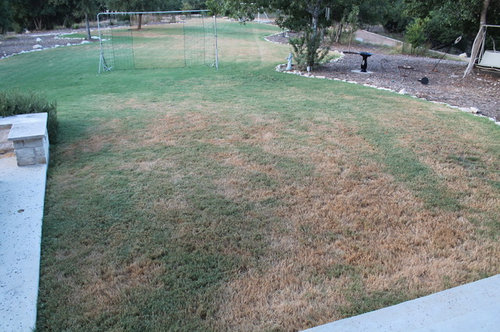
Close up of foreground:
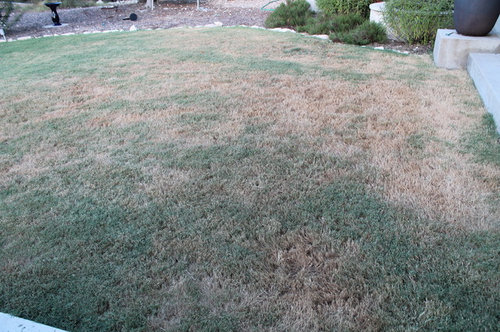
Close up of grass:
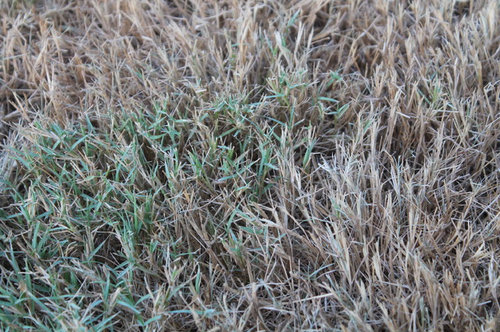
Comments (9)
trussin.22
Original Author8 years agoAlso, I removed two 1 SF areas of turf to check for grubs. Found 1 grub in 2 SF.
dchall_san_antonio
8 years agoThere's one more test you can do for bugs. Put a piece of paper on the grass and wipe your hand through the grass away from the paper. That movement will flick any loose insects onto the paper. You're looking for chinch bugs. I suspect you don't have them, but if you do the treatment is completely different. If you have chinch bugs you can either apply beneficial nematodes (if you want to remain organic) or spray with a chemical insecticide.
If you don't have chinch bugs then this is almost certainly a disease. The rains we've had since last October piled it on leaving many of us with diseased lawns by June. Cracked corn was correct; however, you should be able to find corn meal fairly easily at a feed store. I get it either at Ful-O-Pep stores or Mumme's feed store. Both are milled along Hwy 90 so they're local and available. Deer will smell the corn but they'll have a harder time getting any appreciable amount. Besides you're going to wet it down so it's sort of melted onto the soil surface. Just water enough to wash the corn dust off the grass and down onto the soil. No need to saturate the soil, although if you were doing a normal watering of 1 inch, that would be fine.
You need to bite the bullet and mow it lower. You have to mow it at your mower's lowest setting and bring it up one notch to get it down where it needs to be. Bermuda grows off of stems. When you mow it off from 2.5 inches to 2, the stems are 2 inches tall. When you mow it down to 1 inch, the stems will be 1 inch tall. When the grass blades come out of the stems, they will grow up from the top of the stem. If you can mow down to 1/2 inch and mow it 3x per week, the stems will start to grow horizontally in a survival response to the assault on the upright stems. Then the blades come out of the stems all along the way increasing the density considerably. Check out this thread for pictures of what it looks like.
trussin.22
Original Author8 years agoThank you, dchall, for your advice (and information on countless threads here).
I didn't find any chinch bugs, so I'll try to source corn meal in the area (it isn't carried by my local feed store). Should I hold off on applying milorganite in the meantime?
Regarding mow height, should I wait for temperatures for come down a bit before reducing height? Should it be done all on one day?
Thank you also for the above link - if I lower the mower below 1", I'll need the leveling techniques!
trussin.22
Original Author8 years agoA nearby small town feed store is trying to source corn meal, then I'll try Callahans and Georgetown. In a pinch, I guess I could use cracked corn (which I can get) and top it with milorganite to keep the deer at bay. Again, thanks. I hope to have updated pictures of a lower and greener lawn in a couple months!
trussin.22
Original Author8 years agoFor anyone in the greater north Austin area looking for corn meal, it's available at Georgetown Farm Supply on SH 29 near IH 35.
dchall_san_antonio
8 years agoThat's good information, thanks. Looking forward to the pix in a month.
I'm in Round Rock for a class this week. I might swing by that feed store and look around. My daughter is at Southwestern, so I'm up here sort of frequently.
trussin.22
Original Author8 years agoTwo months later, I'm mowing the lawn at 1" and absolutely love the height of cut (as do my kids). Areas that were previously thriving have recovered well from the scalping, have further thickened, and look great. Areas that were brown have recovered much more slowly.
After numerous armadillo "aerations", I'm not convinced my problem wasn't grubs. While I've yet to find large populations, the diggings and type of deterioration points towards some infestation. Since my last post, I've spread corn meal, half rates of milorganite, and most recently, alfalfa. I've also shampooed areas that seemed most affected by poor growth or recovery. I have had to cut back somewhat on irrigation, but worst areas are being watered with a manual sprinkler. One month ago, I applied light grub control (grub-ex, I believe) in two areas that were routinely hit by armadillos (as confirmed by trail camera). They've not been asactive in those areas since application.
The following photos were taken this evening after mowing, but the overall image doesn't do it justice. I feel that it looks much nicer than 2 months ago, and looks somewhat better in person. That said, areas previously stressed continue to show poor growth and have not thickened or recovered as quickly as hoped.
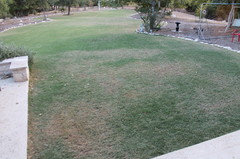
Closeup of foreground in above.
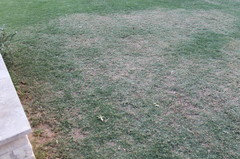
And slightly closer...
Finally, a relatively healthy area: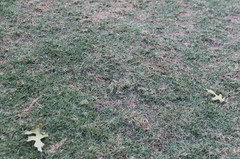
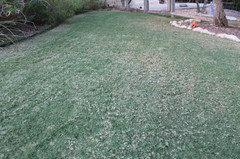
reeljake
8 years agoI like a little step aerator from HD to open the soil & dump that leftover milorganite to help those spots pop back





dchall_san_antonio